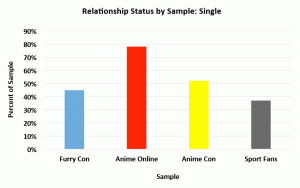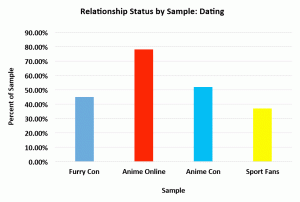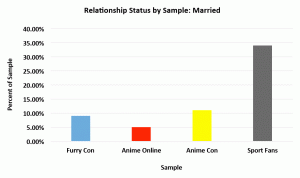We assess relationship status of furries by asking participants to indicate, by checking from a list of all that apply, their current relationship status. The results below are fairly representative of results obtained in any given study,1 and show that there are significant differences in the relationship status of males and females (as assigned at birth): males are three times more likely to be single than females, while females are 2-4 times more likely to be dating, engaged, married, or in another type of relationship. One hypothesis for this difference is based on the idea that furry women are more likely to enter the fandom by way of a significant other; given the high proportion of men in the fandom,2 women may feel they need to justify their presence in the fandom (i.e., being an artist or friend of a furry), an issue discussed in greater depth in Section 12.
When interpreting differences in relationship status across fandoms, age likely plays a significant factor in these results; older participants are more likely to be married, particularly when the age difference between the fandoms amounts to the difference between people in their early 20s and their early 30s. This would explain why fantasy sport fans, the oldest fan group in the sample,4 are the most likely to be married and, by extension, the least likely to be single. This similarly explains why online anime fans, the youngest group, are the most likely to be single and not in a long-term dating relationship. Furries (a convention-going sample), and convention-going anime fans were comparable in their rates of dating, although the A-Kon sample was more likely to be single than furries were.5
This brings us to another category of interest: open and polyamorous relationships. While we acknowledge that these are two distinct (if related) phenomena, results for the two items were comparable, and so they were grouped together in the following figure. As a group, furries are far more likely to engage in open relationships or polyamory than the other groups. One possible explanation for the high rates of polyamory in the furry fandom is that the fandom encourages norms of openness and acceptance,6 which may make it a particularly appealing, non-judgmental place for people who are in polyamorous or open relationships (which are often stigmatized in the general population). Alternatively, the open and accepting nature of the furry fandom may lead furries to consider open relationships and polyamory where, in other contexts, they might otherwise not. Further research is needed to clarify the possible mechanisms underlying these differences.
When furries were asked open-ended questions about the effects of the furry fandom on their relationship,7 qualitative analysis revealed ten primary relationship benefits, in order of frequency:
- Furry was the way I met my partner (online, at conventions, through mutual friends)
- Furry provides us with shared activities to engage in (e.g., cons, fursuiting, doing art)
- Furry is a shared interest we both have, which brings us closer together
- Furry allows my partner and me to express a part of ourselves (emotions, identities)
- The furry fandom provides a space that is accepting of sexual / gender identity or which allows a safe place to express facets of ourselves (e.g., kinks, identity exploration)
- The fandom provides social networks for my partner and me to connect with others
- The fandom has allowed my partner and I to improve as people (e.g., confidence)
- The fandom allows my partner and me to explore facets of ourselves (e.g., through roleplay)
- The fandom provides social support or a means of maintaining our relationship
- The fandom is an important part of our income / business / job (e.g., artist, vendor)
Responses to an open-ended question about negative effects of the furry fandom on relationships showed the following nine primary drawbacks, again listed in order of frequency. It should be noted that positives and negatives were listed at a ratio of about 5:1, and negatives were more common among participants whose partners were not furries.
- The fandom contributes to jealousy (e.g., toward others in the fandom, or for taking up my time)
- Stigmatizing beliefs from my partner or concern about being discovered to be a furry by someone else, who would react negatively
- Specific problem people in local groups or the small, insular nature of local groups (e.g., individuals who are sexually aggressive or poorly-behaved at local meet-ups)
- The fandom is too open toward polyamory, sexuality, kinks, etc.
- Lack of partner’s interest in furry or general dislike of the fandom
- Money problems created by interest in furry (e.g., unable to afford conventions) “Drama” or conflict in the fandom
- Disagreements or concerns about fandom-specific content (e.g., cringe, particular artists)
- Conflict about fandom-related activities (e.g., certain cons, the role of fursuits in sex)
In an online survey8 participants were asked questions about their relationships and relationship satisfaction and furry media consumption. Generally, furries were far more likely to say that being a furry has been beneficial to their relationship and that they were far more likely to argue with their partner over non-furry things than furry-related things. Overwhelmingly, furries reported that their involvement in furry-related activities rarely leads to conflict with their partners (with a greater tendency for conflict for furries whose partners are not furry.
This study allowed us to test (and find evidence for) an unusual model showing hte relationship between furry content consumption and relationship satisfaction. Specifically for participants whose partner is not a furry, greater furry content consumption is associated with the perception that furry is helping their relationship, leading to greater relationship satisfaction. This same pattern is not found for furries whose partners are also furries. One possible explanation is the fact that furries who are able to consume furry content despite having a non-furry partner may be appreciative of this (as opposed to being with a partner who is opposed to their openly consuming furry content), which may lead to the perception that being able to be furry is helping their relationship and, ultimately that they have a more satisfying relationship. More research is needed to further investigate this possibility.





As someone who is now actively looking for a possible female companion within this fandom, I’m now starting to think I’m looking in the wrong place due to the fact that some girls are referring themselves to be men. I don’t know what to think.
Good thing it doesn’t matter what you think, Mike!
Why analyze relationship status by “sex assigned at birth” rather than by a person’s actual gender identity? I understand that it’s easier to analyze binary variables, and they make for cleaner-looking graphs, but I’m not sure you’re doing yourselves any favors by inexplicably lumping together cis men, trans women, and some non-binary people into a single analytical group. It doesn’t seem analytically sound, for two reasons:
1. You’re trying to draw conclusions about relationships, which are more likely to be defined based on gender identity rather than sex assigned at birth, particularly in a highly liberal community like the furry fandom.
2. You’re dividing up your findings by sexual orientation, as defined by survey participants themselves based on their own genders, not on their sex at birth. A trans woman solely attracted to other women would have reported herself as “exclusively homosexual”; that implies that, if your intent is to create a graph that enables you to compare heterosexual women to homosexual women or homosexual men to homosexual women, misclassifying exclusively homosexual trans women as “homosexual men” brings you to misleading conclusions.
Given that one-eighth of your sample identifies as some flavor of trans– enough to actually mess up your analysis!– I’m hoping you’ll revisit this. Thanks for your time, and for the great work in general.
Science evolves, and some of that data was derived from a 2011 study. If and where we have only asked for sex at birth, it is likely an older study FYI. We’ve since brought on a trans expert with lived experience, and we are largely addressing these issues in our current work.
…and thanks for the comment, question, and the compliment! We appreciate the feedback and the support 🙂
It seems that the Relationship Status by Sample: Dating graphic shows the percentages for Single?
We’ll check it out. Thanks 🙂